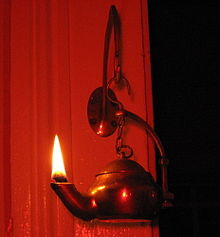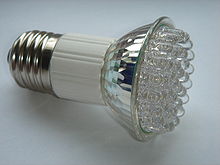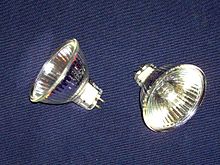Luminaire
![]()
This article is about the illuminant lamp. For other meanings, see Lamp (disambiguation).
A lamp ( ![]() , French lampe, from Ancient Greek λαμπάς lampás "torch, lamp") in the sense of DIN 5039 is a technical component of a luminaire that generates light by energy conversion and serves for illumination. For electric lamps, the term illuminant is often used. In general language, the terms lamp and luminaire are usually equated.
, French lampe, from Ancient Greek λαμπάς lampás "torch, lamp") in the sense of DIN 5039 is a technical component of a luminaire that generates light by energy conversion and serves for illumination. For electric lamps, the term illuminant is often used. In general language, the terms lamp and luminaire are usually equated.

Copper oil lamp (19th century)

Lamp with light emitting diodes and Edison base E27
Term
DIN 5039 defines the terms light, lamp and luminaire. Accordingly, a lamp is, quote: "a technical design of an artificial light source which is primarily intended to produce light, i.e. to shine or illuminate." The luminaire is defined as, quote, "a device used to distribute, filter, or transform the light from lamps, including the components necessary to fix, protect, or operate the lamps." The term "illuminant" is not used in this standard, nor in other German-language standards on the subject of lighting (DIN EN 12665, DIN EN 13032-1, DIN EN 60969, DIN IEC 60810, etc.). Sheet 1 of VDI 4700 defines lamp as, quote: "the illuminant contained in a luminaire". This definition is made with reference to the withdrawn BGR 131-1. In the aforementioned VDI guideline, the colloquial equation of the terms lamp and luminaire as designating the entire lighting device (cf. e.g. kerosene lamp, desk lamp, etc.) is described as incorrect.
The lamp is specified in DIN 5039, as well as colloquially, by additions to compound terms. In the case of electric lamps such as incandescent lamps, halogen lamps, gas discharge lamps, high-pressure discharge lamps and fluorescent lamps, the process by which the light is produced is usually described in this way. In the case of chemical-physical lamps, the lamp cannot usually be technically separated from the luminaire, so that the lamp is the dominant part of the luminaire and thus characterises the term. Examples include: the oil lamp, the lantern (which contains a candle), the kerosene lamp and the carbide lamp. For electric light sources that can be used directly in replacement for incandescent lamps, because they fit into existing sockets and come in similar luminosities, the term replacement lamp or retrofit is increasingly used (for example, in terms such as LED replacement lamp or LED retrofit). Such lamps are also often referred to as energy-saving lamps after the intended purpose of the replacement.
History
→ Main article: History of lighting
The find of a stone with a flat dented surface and a burn mark from Edertal-Buhlen from the Middle Palaeolithic is considered the oldest find of a lamp in the world. Until the invention of the argand lamp in the late 18th century, the petroleum lamp at the beginning and the gas lamp around the middle of the 19th century, lamps were usually simply shaped, open or covered vessels made of clay, stone, glass or metal, which burned vegetable oil or animal fat by means of a wick (oil lamp) or contained candles. The invention of the electrically powered incandescent lamp was of epoch-making importance for modern lighting.
Newer lamp types include: compact fluorescent lamps, halogen incandescent lamps, metal halide lamps, arc lamps and light emitting diodes. As one of the essential features, all electrically operated lamps have sockets made of metal or ceramic, which provide the electrical and mechanical connection to the luminaire. An exception is the sulphur lamp, which is only mechanically connected to the luminaire. In order to make this multitude of newer light sources comparable in their technical structure, light colour and other peculiarities, the ILCOS standard was developed by the International Lighting Commission.

Halogen lamps
Search within the encyclopedia